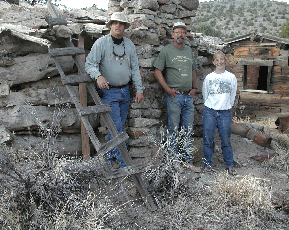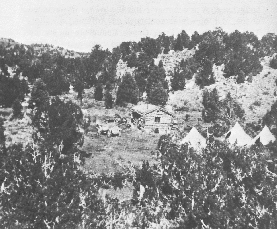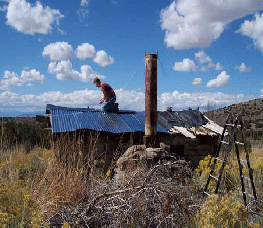|
 |
 |
 |
|||
|
Counting Sheep: One Family’s Story in the Building of Nevada Gregory R. Seymour Trails Past Inc. Douglas (Griswold) Merkler Area Resource Soil Scientist, USDA - Natural Resources Conservation Service Lois F. Merkler Department of Biological Sciences, University of Nevada Las Vegas The livestock industry is an important to the history of Nevada and the west. Sheep were found to be ideally suited with advantages over cattle because they could be moved over the rough, dry landscapes of the Great Basin without much effort. Chauncey W. Griswold arrived in the Elko area in 1877 when he was ten. Chauncey established what was to become one of Nevada’s significant ranching families. Morley Griswold, Chauncey’s son, was the 16th Governor of Nevada. Gordon Griswold, another son, was the Director of the National Advisory Board Council to the U.S. Grazing Service, and carried on the family tradition in the sheep industry. For the winter, the Griswold sheep trailed south 300 miles to the southern headquarters near Cave Valley. The Griswold family cabins at the southern headquarters are explored as an example of rural vernacular architecture woven into a landscape quickly disappearing in modern Nevada. Many of us have seen old buildings and structures at the end of an old road, at the mouth of a canyon, or across a field. Rural vernacular architecture evokes a feeling of the struggle between humans and the environment. This paper is about one family’s story in our states rural environment. These tiny cabins are just a small part of the Griswold family legacy and their effect on Nevada’s economic development is, in part represented through what we will see today. The sheep industry began in Nevada in August of 1852. Richard L. Wootton led an expedition of 9,000 head of domesticated sheep, Mexican Churros, into Nevada near Ibspah. Earlier, Wooton had accompanied John C. Fremont on one of his trips along the emigrant trail displaying his expertise as a trail boss. From Ibspah, they pushed the sheep westward to the Humboldt River, following the low, late-summer flows, and ended up along the tall cottonwoods of the Carson River. This was one of the first of many sheep drives specifically addressing the demand for meat generated by the famous gold rush of 1849 in California. In the spring of 1853, Kit Carson and Lucien Maxwell brought sheep from New and Old Mexico to the California miners. Stopping for a time at the meadows near Carson City to fatten the sheep, they then headed over the Sierra Nevada Mountains. On Kit Carson’s way home, he saw many more sheep headed to California. By 1865, the Nevada census documented that the sheep industry had become established in Washoe, Humboldt, Lander, and Nye counties. By 1870, climatic and political factors started the migration of the livestock industry out of California and into Nevada. The result was a very rapid expansion of the livestock industry into the Silver State. It was during this period that this economic enterprise here developed distinct geographic regions: north of the Humboldt, the Central Region, and the Southern Region. Because trailing sheep to market was difficult, and reducing the profit margin, shipping centers were developed near the great ranches of Nevada at Elko, Wells, Battle Mountain, Winnemucca, and Reno. Willard Billy Smith Griswold, one of four brothers came first to Nevada in about 1872 and established a homestead. Alfred Morley followed in 1877 and family folklore reveals that he brought the youngest of the brothers Chauncey to Nevada around 1881. The 1880 Missouri census still accounts for Chauncey there. The 4th brother, Isaac had never actually planned to come to Nevada. He made a visit by train with two of his sisters, Mary and Almira in 1881. He liked it so well that, he too stayed. Mary died from tuberculosis at Billy's ranch in Ruby Valley in 1882. Almira ended up marrying David Lantaff at Wells in 1885; most likely introduced through Alfred. Alfred and David Lantaff are enumerated together as "hired hands" in the 1880 census of North Ruby, Elko Co., NV. Chauncey Warner Griswold, my Great Grandfather was born September 21, 1867. He would have been about 14 years of age when moving to Halleck Station, Nevada, from St. Joseph, Missouri to work with his brothers Alfred and Billy Griswold. Chauncey acquired his first sheep as compensation for watching his neighbors flocks. By the time he was 20, he had accumulated enough property to marry Matie Dakin, of Lamoille, in 1888. They eventually settled on a ranch in Lamoille, Nevada in 1897. Later, Chauncey Griswold added the Health, Miller, and Saval ranches to his holdings. In the summertime, Chauncey ran his flocks on the western slope of the Ruby Mountains from the Sheep Ranch. This was the headquarters of the ranch operation until the ranch was sold. Chauncey began his wintering of his sheep south to the Currie area, and Coal Valley in White Pine County. The outfit ran 10,000 to 12,000 sheep at its peak. After Thanksgiving, for the duration of the winter, Chauncey and his sheepherders trailed south to Cave Valley, a walk of roughly 300 miles. They did not return to Lamoille until after lambing season in the spring, usually at Spruce Mountain. At the south end of the Schell Creek Range, Chauncey established his winter headquarters approximately 2 miles northwest of Silver King Pass. Here, protected along the toe slopes of the Schell Creek Range, he built a simple log cabin around 1900. This would become known as Griswold Well, and is currently labeled as such on the Silver King 7.5 minute USGS quadrangle. Chauncey was associated with the NevadaLand and Livestock Company and was its president at the time of his death. During his later years, he devoted more of his attention to sheep instead of cattle. His holdings were extensive and his sheep ranged over thousands of acres. Chauncey became the senior partner in the firm of Griswold and Henderson. Charles B. Henderson was a U.S. Senator from Nevada and the city of Henderson’s namesake. Sheep ranching was not always easy. One year, Chauncey was hunting for his sheep camp in the Spruce Mountain area to assist his men, who were shorthanded. He met John Boundy on the mountain who directed him to their camp. Later that day he met Boundy again and told him of his encounter with Will Norton. Chauncey had trouble with Norton and hurt him badly. Griswold asked Boundy to go to Norton’s aid. Griswold then left for Elko to surrender to authorities and Boundy went to Griswold’s camp, gathered Billy Bell, A.J. Thomas and a man only known as Stewart and together they went to find Norton. When they reached the scene of trouble, they found Will Norton lying dead on the ground with a bullet in his groin, his head uphill, left hand clenched, right hand palm downward across his chest. Both hands encased in heavy buckskin gloves. About eighteen inches from the body lay a 41-Colt revolver which was cocked. Chauncey maintained that he, met Norton while hunting his sheep camp and the two had a heated conversation about the ownership of land around camps in Spruce Mountain. Chauncey told him that, he owned the 100 acres at Spruce Springs. Norton called him a liar, saying he only owned 80 acres, and at the same time pulled out his gun. Griswold got off his horse on the side opposite Norton, grabbed his rifle, a .30-30 Savage, from the scabbard and shot Norton. Norton did not shoot. Chauncey’s shot struck Norton in the groin, passing through a pocket containing nails and forcing one of the nails into the body. The jury rendered a verdict of justifiable homicide. Both Chauncey, and later his son Gordon, served as president of the National Woolgrowers Association. While serving as president at a National Woolgrowers Association meeting in Ely, Nevada, Chauncey became ill. He went to San Diego where he thought he would feel better at the lower elevations. He died December 31st, 1928. Gordon took over the family business immediately; he had been well trained in the work. Gordon’s brother, Morley Griswold, became an attorney and eventually Lieutenant Governor, and then the 16th Governor of Nevada. Gordon bought out Henderson’s interest in the Griswold and Henderson company. At the time that the BLM was activated, Gordon Griswold was the Director of the National Advisory Board Council to the United States Grazing Service; he served as the president from 1940-1944. He presided over the early meetings and hearings of disputes between ranchers and the federal government (Sawyer, 1971). In the winter of 1952, Gordon was instrumental in the hay lift for the Livestock Emergency Relief Program. He directed the task of bringing aid and supplies to people and livestock in Northeastern Nevada. Gordon, like his father, married a Nevada girl, the attractive Kitty, daughter of J. F. Christopherson who was a rancher from Baker, Nevada. Theses examples of rural vernacular architecture are an expression of personality, human need, and the environment where they are situated. Each building and structure takes on the personality of the builder, then through time, its use. After abandonment, they begin to express disuse, abuse, and perhaps their alternative uses. As they disappear, forever gone are the stories of how these people lived in the landscape. One can only wonder how did these people use the land and use the buildings. Why did they live here? Where did they go? Each structure comes from the environment, for the most part, using local materials, each in unique and interesting ways. They are built to fill a need for shelter, warmth, physical and mental comfort and for protection of humans, animals or things. Because these were built before building codes, often with non-standard materials, they explicitly express the mental template of the builder or builders. They also exhibit clues into the problem-solving process inherent with construction of any form. These building often offer clues to the sequence of their manipulation and additions. As Stewart Brand says, as buildings age, they become personalities of their own reflecting the builders, and subsequent inhabitants. As Doug mentioned, the Griswold Cabins were an integral part of the family sheep business. The site is situated at the transition between the sagebrush and pinion-juniper plant communities. The cabins had been built at the base of a rocky hill that provided some shelter from winds. The well and nearby meadow provided water and forage for the animals. Numerous axe-cut stumps show the trees that were used for building materials for the earliest cabin, corrals, and fences. This first cabin had been made of large roughly hewn pinion pine logs joined together with simple saddle notching. It is likely that the logs were chinked with mud or other material, but no evidence remains of that today. Juniper logs as roof joists ran from front to back. These in turn, were covered with smaller branches laid in a perpendicular manner and then covered with juniper bark. Finally, a layer of soil covered the roof completing the building. Typically, wool blankets were hung along the interior perimeter walls and ceiling in a tent-like fashion. The door faced west with a view of a meadow and the Grant Range off in the distance. A small window was in the south wall. Opposite the door a stone fireplace was a necessary element for keeping warm when the cabins were occupied in the winter. Gordon built the second cabin at Griswold Well. We know from the story passed down through the family that it was around 30 years later sometime before November of 1933, as his wife Kitty insisted on a separate cabin for her and their brand new baby girl. It was made of recycled railroad ties, square notched in the corners. The larger of the two cabins, it also had a stone fireplace in the rear wall. Bunks and bed frames can still be found in this building today. wood and wire corral, wooden outbuilding, and possible cold storage locker were found nearby. No privy was located. Although there was always work to be done, visitors to the camp managed to have a little fun. In 1947 one of the Basque shepherds, Tom Eager, noted that Gordon and his brother Morley Griswold, then Lt. Governor, showed up at the cabins with a deer hunting party from Fallon. Gordon and his son young Chan Griswold slept in the sleeper cabin while others slept in tents or in sleeping bags under the stars. By this time, the older cabin was generally used for cooking. During the evaluation process, we discovered that the roof of the southerly cabin was in danger of imminent collapse. With agency approval, we placed several 2 x 4 boards under the damaged main beams. We did nothing to the building that was not completely reversible. Our plans are to develop and submit a plan to the BLM and SHPO to stabilize and complete minimal restoration of the older of the two cabins. As part of this plan we will provide recommendation for public interpretation of the site. At this point in history, we will probably be the last ones to see many of these buildings and structures. Most have already disappeared and the remaining others are quickly being reclaimed by nature. When they have disappeared, the stories of the people as they relate to these buildings and the associated landscapes will also be gone. |
|
[Trails Past] [History East NV] [Griswold Well] [NV Geodetic Survey] [Wilderness] [Classic Nevada] [Lynx] |


